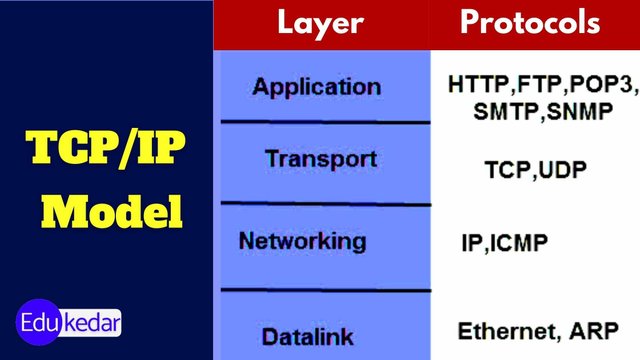The TCP/IP model, also known as the Internet Protocol Suite, is a conceptual framework used to understand and implement network communications in computers. It was developed by the United States Department of Defense to enable communication over large-scale networks, such as the internet. The TCP/IP model is divided into four layers, each responsible for specific aspects of network communication. Here’s an overview:
1. Application Layer
- Purpose: This is the topmost layer, where network applications and their protocols operate. It provides services to the end user and handles high-level protocols, issues of representation, encoding, and dialog control.
- Examples: HTTP, FTP, SMTP, DNS, POP3.
2. Transport Layer
- Purpose: This layer ensures that data is transferred reliably and without errors. It provides end-to-end communication, data flow control, and error checking.
- Protocols:
- TCP (Transmission Control Protocol): Provides reliable, connection-oriented communication. It ensures that data is delivered in order, without errors, and without duplicates.
- UDP (User Datagram Protocol): Provides an unreliable, connectionless communication service. It is faster but does not guarantee the delivery of packets.
3. Internet Layer
- Purpose: This layer is responsible for routing packets across the network. It defines the logical addressing (IP addresses) and manages packet forwarding and routing.
- Protocol:
- IP (Internet Protocol): Handles the addressing and routing of data packets. IP is responsible for delivering packets from the source host to the destination host based on IP addresses.
4. Link Layer (or Network Interface Layer)
- Purpose: This is the lowest layer, which deals with the physical transmission of data over a network. It is responsible for the hardware addressing and for converting binary data into signals suitable for transmission over the physical medium.
- Examples: Ethernet, Wi-Fi, ARP (Address Resolution Protocol).
Comparison with OSI Model
The TCP/IP model is simpler and has fewer layers than the OSI model, which has seven layers. The TCP/IP model's layers correspond roughly to the OSI model's, but they are more general. The TCP/IP model is often used because it is directly associated with the protocols used on the internet.
Key Points:
- TCP/IP stands for Transmission Control Protocol/Internet Protocol.
- It is a set of protocols that govern how data is transmitted over the internet and similar networks.
- It is the foundational model for network communication.
Understanding the TCP/IP model is crucial for working with network technologies and protocols, as it forms the basis of the internet's architecture.

Congratulations, your post has been upvoted by @upex with a 0.36% upvote. We invite you to continue producing quality content and join our Discord community here. Visit https://botsteem.com to utilize usefull and productive automations #bottosteem #upex
Downvoting a post can decrease pending rewards and make it less visible. Common reasons:
Submit